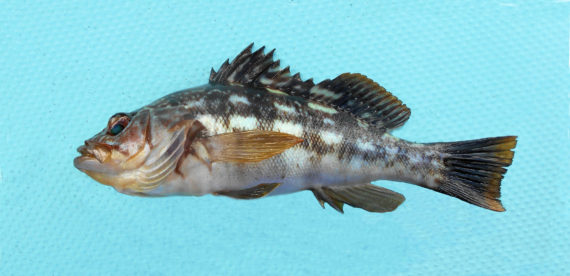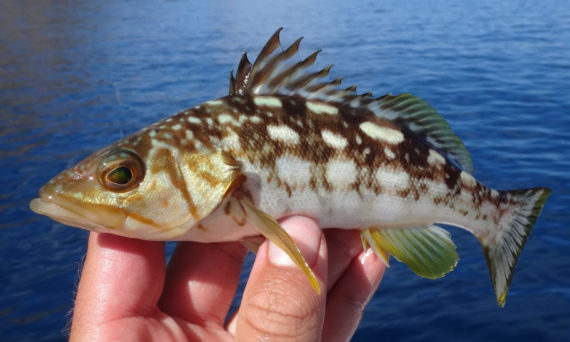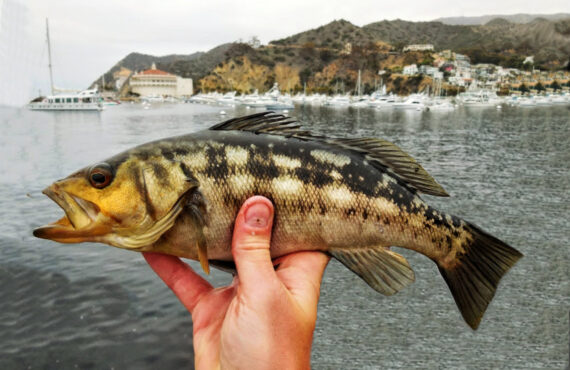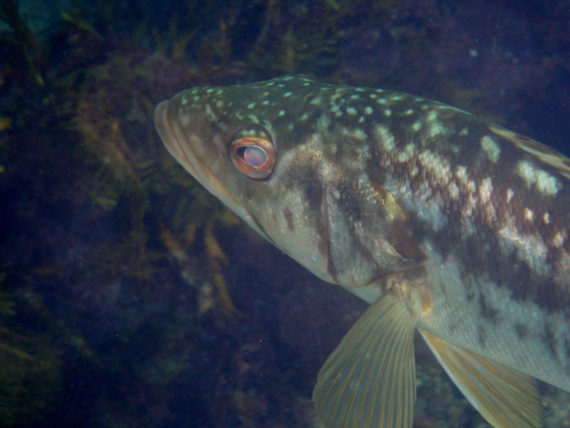Calico Bass, Paralabrax clathratus
 Calico Bass, Paralabrax clathratus. Fish caught out of coastal waters La Bocana, Baja California Sur, April 2016. Length: 25 cm (9.8 inches).
Calico Bass, Paralabrax clathratus. Fish caught out of coastal waters La Bocana, Baja California Sur, April 2016. Length: 25 cm (9.8 inches).
 Calico Bass, Paralabrax clathratus. Fish caught from coastal waters off Catalina Island, California, October 2015. Length: 18 cm (7.1 inches). Catch, photograph, and identification courtesy of Ben Cantrell, Peoria, Illinois.
Calico Bass, Paralabrax clathratus. Fish caught from coastal waters off Catalina Island, California, October 2015. Length: 18 cm (7.1 inches). Catch, photograph, and identification courtesy of Ben Cantrell, Peoria, Illinois.
 Calico Bass, Paralabrax clathratus. Fish caught from coastal waters off Catalina Island, California, October 2015. Length: 24 cm (9.4 inches). Catch, photograph, and identification courtesy of Josh Leisen (joshadventures.com), Gaylord, Michigan.
Calico Bass, Paralabrax clathratus. Fish caught from coastal waters off Catalina Island, California, October 2015. Length: 24 cm (9.4 inches). Catch, photograph, and identification courtesy of Josh Leisen (joshadventures.com), Gaylord, Michigan.
 Calico Bass, Paralabrax clathratus. Fish caught in coastal waters off Bahía Santa Rosalillita, Baja California, September 2015. Catch and photograph courtesy of Barry Mastro, Escondido, California.
Calico Bass, Paralabrax clathratus. Fish caught in coastal waters off Bahía Santa Rosalillita, Baja California, September 2015. Catch and photograph courtesy of Barry Mastro, Escondido, California.
 Calico Bass, Paralabrax clathratus. Fish caught in coastal waters off San Clemente Island, California, October 2018. Length: 34 cm (13 inches). Catch, photograph and identification courtesy of Chris Wheaton, Fullerton, California.
Calico Bass, Paralabrax clathratus. Fish caught in coastal waters off San Clemente Island, California, October 2018. Length: 34 cm (13 inches). Catch, photograph and identification courtesy of Chris Wheaton, Fullerton, California.

 Calico Bass, Paralabrax clathratus, Breeding Male. Fish provided by the commercial fishermen of the greater Los Cabos area, Baja California Sur, August 2013. Length: 39 cm (15 inches).
Calico Bass, Paralabrax clathratus, Breeding Male. Fish provided by the commercial fishermen of the greater Los Cabos area, Baja California Sur, August 2013. Length: 39 cm (15 inches).
 Calico Bass, Paralabrax clathratus. Underwater photograph taken in coastal waters off La Jolla, California, October 2014. Photograph courtesy of Bob Hillis, Ivins, Utah.
Calico Bass, Paralabrax clathratus. Underwater photograph taken in coastal waters off La Jolla, California, October 2014. Photograph courtesy of Bob Hillis, Ivins, Utah.
The Calico Bass, Paralabrax clathratus, is a member of the Sea Bass or Serranidae Family, this is also known as the Kelp Bass, and in Mexico as cabrilla sargacera and verdio. Globally, there are nine species in the genus Paralabrax, of which five are found in Mexican waters, all in the Pacific Ocean.
The Calico Bass is very similar in body structure to the freshwater Largemouth Bass, Micropterus salmoides. Their upper head is olive green with random yellow spots and their upper back is mottled with white, olive-green, and black markings. There are two rows of rectangular white blotches in a net pattern along their back. Their anal fin has 3 spines and 7 or 8 rays; and their dorsal fin has 10 or 11 spines and 12 to 14 rays. A key to identification are the third and fourth dorsal spines, which are of equal length and approximately twice the length of the second spine. They have 32 to 36 gill rakers.
The Calico Bass is found within and near kelp beds at depths up to 40 m (130 feet). They reach a maximum of 72 cm (2 feet 4 inches) in length. As of January 1, 2024, the International Game Fish Association world record stood at 59 cm (23 inches), with the fish caught in waters off Cedros Island, Baja California, Mexico in September 2012 and 6.5 kg (14 lbs 7 oz) with the fish caught in coastal waters off Newport Beach, California in October 1993. They feed on crustaceans and small fish. They do not undergo a mid-life sex change, however, the males are sexually dichromatic during spawning season (June to September), as evidenced by a significant change in facial coloration (photo above).
The Calico Bass is a resident of Mexican waters of the Pacific Ocean but has a limited range being found from north of Cabo San Lucas, Baja California Sur, northward along the southwest, central and northwest coasts of Baja, with the southern range established by the fish pictured above.
The Calico Bass is most likely confused with the Barred Sand Bass, Paralabrax nebulifer (dark blotches on upper two-thirds of body and tail base; third dorsal spine two and a half times longer than second spine); the Goldspotted Sand Bass, Paralabrax auroguttatus (dense orange spots covering head, body, and fins; third dorsal spine three times longer than second spine); the Parrot Sand Bass, Paralabrax loro (orange spots and lines covering head; seven dark bars on the sides; third dorsal spine three times longer than second spine); and the Spotted Sand Bass, Paralabrax maculatofasciatus (numerous black, brown, and orange spots covering body; dark bar from eye to gill cover; third dorsal spine three times longer than second spine).
From a conservation perspective the Calico Bass is currently considered to be of Least Concern with stable widely distributed populations. It is considered to be an excellent food fish and an important game fish with annual catch levels in excess of 500,000 by California party boats.